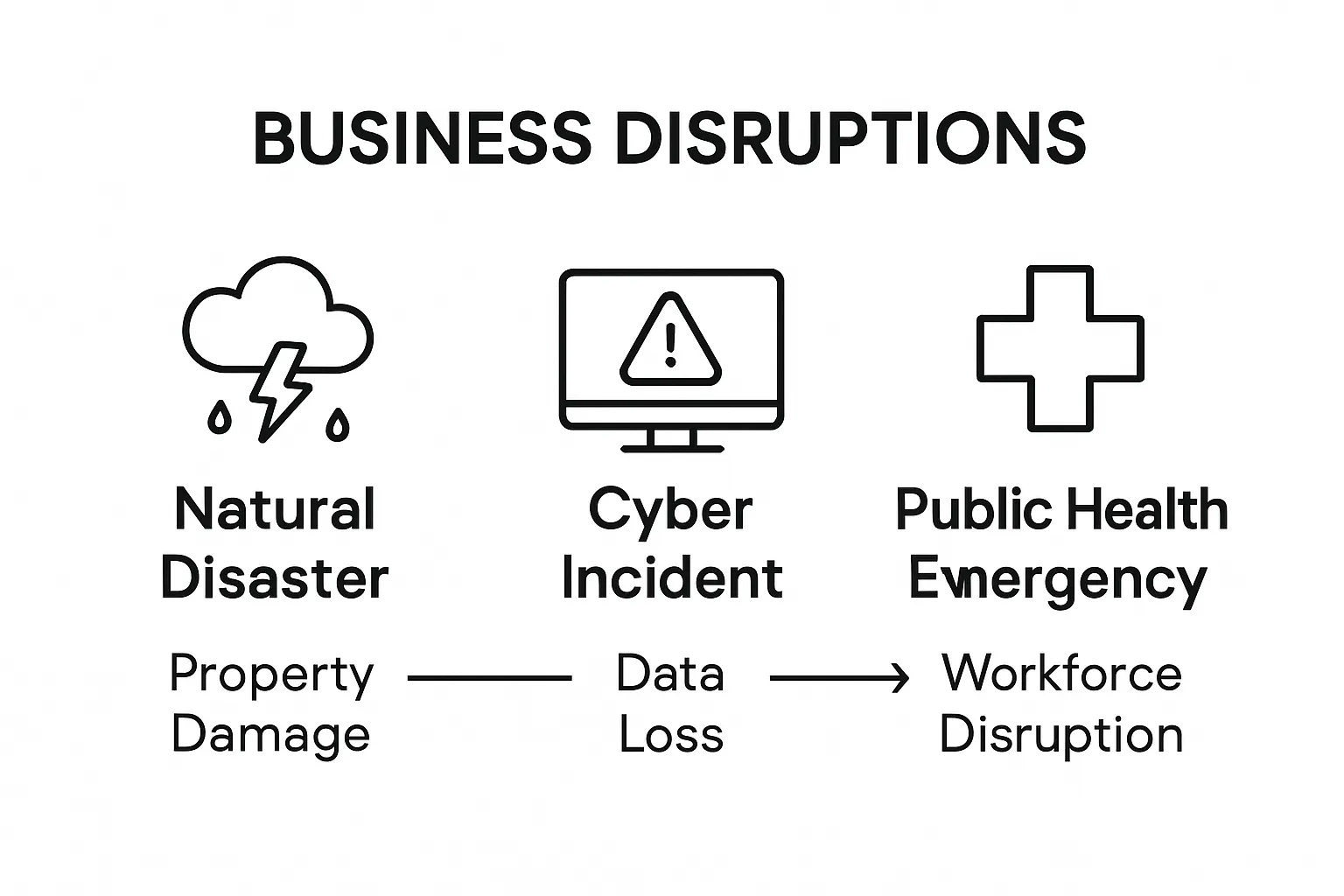Disaster planning can decide whether a business bounces back or shuts its doors for good. FEMA reports that nearly 40 percent of small businesses never reopen after a disaster. That sounds harsh and almost final, right? Yet the real surprise is most losses can be avoided with planning that goes far beyond just emergency drills or basic insurance.
Table of Contents
- What Is Disaster Planning For Businesses?
- Why Disaster Planning Is Essential For Business Resilience
- Key Concepts In Disaster Planning And Preparedness
- How Disaster Planning Works: Frameworks And Strategies
Quick Summary
| Takeaway | Explanation |
|---|---|
| Conduct thorough risk assessments. | Identify specific vulnerabilities and potential disruptions unique to your organization to inform planning. |
| Develop clear communication protocols. | Establish guidelines for communication during crises to ensure rapid response and coordination among stakeholders. |
| Integrate technology into disaster planning. | Use digital tools for real-time monitoring and responsive strategies to enhance organizational resilience. |
| Create backup systems and recovery strategies. | Maintain alternative solutions for maintaining operations while minimizing financial losses during disruptions. |
| Prioritize continuous training and updates. | Regularly revisit and practice your disaster plan to ensure adaptability and organizational preparedness. |
What is Disaster Planning for Businesses?
Disaster planning is a strategic process where businesses proactively prepare for potential emergencies that could disrupt normal operations. According to FEMA, disaster planning involves identifying potential risks, developing comprehensive response strategies, and creating systematic approaches to maintain business continuity during unexpected events.
Core Components of Disaster Planning
At its foundation, disaster planning encompasses a holistic approach to organizational resilience. Comprehensive disaster planning goes beyond simple emergency response and involves intricate preparations across multiple operational domains. The primary objective is protecting human resources, maintaining critical business functions, and minimizing potential financial and reputational damages.
To help clarify the key elements of disaster planning covered in this section, the following table outlines each component and its primary focus.
| Component | Description |
|---|---|
| Risk assessment and hazard identification | Evaluates potential threats and disruptions unique to the business |
| Emergency communication protocols | Provides guidelines and channels for crisis-related communication |
| Business continuity and recovery strategies | Ensures essential functions continue and outlines recovery steps |
| Backup systems and redundant infrastructure | Maintains operational capabilities through alternate systems |
Key elements of disaster planning include:
- Risk assessment and hazard identification
- Development of emergency communication protocols
- Creation of business continuity and recovery strategies
- Establishment of backup systems and redundant infrastructure
Understanding Business Vulnerabilities
Every organization faces unique potential disruptions. These can range from natural disasters like hurricanes and earthquakes to technological failures, cybersecurity breaches, or global health emergencies.
 Ready.gov emphasizes that understanding an organization’s specific vulnerabilities is crucial in developing an effective disaster plan.
Ready.gov emphasizes that understanding an organization’s specific vulnerabilities is crucial in developing an effective disaster plan.
Businesses must conduct thorough risk assessments that analyze potential scenarios specific to their industry, geographic location, technological infrastructure, and operational dependencies. This involves identifying critical business functions, potential points of failure, and developing strategies to ensure rapid recovery and minimal operational interruption.
Successful disaster planning requires ongoing commitment, regular training, periodic plan updates, and a proactive organizational culture that prioritizes preparedness and adaptability in an increasingly complex and unpredictable business landscape.
Why Disaster Planning is Essential for Business Resilience
Disaster planning transcends simple risk management. It represents a critical strategic investment that determines an organization’s ability to survive and thrive during unexpected challenges. Small Business Administration research indicates that businesses without robust disaster preparedness are significantly more vulnerable to prolonged operational disruptions and potential financial collapse.
Financial Protection and Survival
Business continuity directly correlates with effective disaster planning. When unexpected events occur, organizations with comprehensive preparedness strategies can minimize financial losses and protect their fundamental operational infrastructure. This proactive approach involves understanding potential economic vulnerabilities and developing strategic mechanisms to mitigate potential risks.
Key financial protection strategies include:
- Establishing emergency financial reserves
- Creating comprehensive insurance coverage
- Developing alternative revenue generation pathways
- Implementing rapid recovery financial protocols
Operational Resilience and Competitive Advantage
Companies that invest in comprehensive disaster planning gain a significant competitive advantage. These organizations demonstrate superior adaptability, showing stakeholders their capacity to navigate complex and unpredictable business environments. Disaster planning enables businesses to respond quickly, maintain critical functions, and protect their reputation during challenging circumstances.
Moreover, well-prepared organizations can transform potential crises into opportunities for innovation and strategic repositioning. By anticipating potential disruptions and developing flexible response mechanisms, businesses can emerge stronger and more refined after experiencing challenging events.
The ultimate goal of disaster planning extends beyond mere survival.
The table below compares financial and operational benefits businesses gain from effective disaster planning to highlight the importance of investing in preparedness.
| Benefit Type | Key Advantages |
|---|---|
| Financial Protection | Minimizes financial losses, maintains emergency reserves, and ensures insurance coverage |
| Operational Resilience | Enables rapid recovery, maintains critical functions, and protects business reputation |
| Competitive Advantage | Demonstrates adaptability, supports stakeholder confidence, and enables innovation |

Key Concepts in Disaster Planning and Preparedness
Disaster planning involves a complex framework of strategic approaches designed to protect organizations from potential operational disruptions. Occupational Safety and Health Administration emphasizes that effective preparedness requires comprehensive strategies addressing multiple potential scenarios and organizational vulnerabilities.
Risk Assessment and Vulnerability Analysis
Risk assessment forms the foundational element of disaster preparedness. This systematic process involves identifying potential threats, evaluating their potential impact, and understanding an organization’s specific vulnerabilities. Businesses must conduct thorough analyses that examine both internal and external risk factors, considering technological, environmental, human, and operational dimensions.
Key components of comprehensive risk assessment include:
- Identifying potential hazard types and probability
- Evaluating organizational critical infrastructure
- Assessing potential financial and operational consequences
- Developing scenario-specific mitigation strategies
Emergency Response and Communication Protocols
Effective disaster preparedness demands robust emergency response mechanisms. Organizations must develop clear, actionable communication protocols that enable rapid information dissemination, coordinated decision making, and structured response strategies during crisis situations. These protocols should provide explicit guidelines for different potential scenarios, ensuring all stakeholders understand their roles and responsibilities.
Successful emergency communication strategies require:
- Establishing clear chain of command
- Creating multiple communication channels
- Developing standardized response templates
- Implementing regular training and simulation exercises
The ultimate goal of disaster planning is not merely survival but creating an adaptive organizational culture capable of responding dynamically to unexpected challenges. By integrating strategic foresight, comprehensive risk management, and flexible response mechanisms, businesses can transform potential vulnerabilities into opportunities for resilience and continuous improvement.
How Disaster Planning Works: Frameworks and Strategies
Disaster planning represents a systematic approach to organizational resilience that transforms potential vulnerabilities into structured preparedness. National Institute of Standards and Technology highlights that effective disaster planning requires comprehensive frameworks integrating technological, human, and strategic components to create adaptive response mechanisms.
Comprehensive Planning Frameworks
Strategic disaster planning goes beyond simple emergency response. It involves developing intricate frameworks that map potential scenarios, identify critical organizational functions, and create multidimensional strategies for maintaining operational continuity. These frameworks serve as dynamic blueprints that evolve with changing organizational and environmental conditions.
Key elements of comprehensive planning frameworks include:
- Holistic risk identification processes
- Scenario modeling and simulation
- Interdepartmental coordination mechanisms
- Adaptive response strategy development
Technology and Digital Infrastructure Integration
Modern disaster planning increasingly relies on advanced technological solutions to enhance organizational resilience. Digital tools enable real-time monitoring, predictive analytics, and rapid communication strategies that transform traditional emergency response approaches. Organizations can leverage technology to create more responsive, flexible, and intelligent disaster preparedness systems.
Technological integration strategies encompass:
- Cloud-based backup and recovery systems
- Advanced communication platforms
- Predictive risk modeling software
- Automated emergency response triggers
Successful disaster planning requires a dynamic approach that recognizes organizational complexity, technological capabilities, and the unpredictable nature of potential disruptions. By developing flexible, technology-enabled frameworks, businesses can transform potential vulnerabilities into opportunities for strategic adaptation and continuous improvement.
Build Real Resilience With Powerful PDF Disaster Planning Tools
When disaster strikes, every second counts and document chaos can make recovery even harder. You have read how essential it is to protect your business workflows and ensure secure, rapid access to critical information as described in the core concepts of disaster planning and business continuity above. Mapsoft.com delivers the specialized software solutions you need to make your disaster response efficient and reliable, cutting risks related to document loss, access delays, and compliance slips.

Take control now by integrating Mapsoft PDF Hub into your organization. Automate your document management, streamline your workflows for PDF and Adobe files, and ensure backup or recovery tasks are handled seamlessly. From merging and splitting essential documentation to securing and repairing files after an incident, our web platform and Acrobat plug-ins give you peace of mind and a crucial edge during emergencies. Visit Mapsoft.com today and choose advanced, scalable disaster planning solutions for your unique business needs. Don’t wait for the next disruption to uncover vulnerabilities—act now and prepare your business for anything.
Frequently Asked Questions
What is disaster planning for businesses?
Disaster planning for businesses is a strategic process that involves preparing for potential emergencies that could disrupt normal operations. It includes identifying risks, developing response strategies, and creating systematic approaches to maintain business continuity during unexpected events.
Why is disaster planning essential for business resilience?
Disaster planning is crucial for business resilience as it enables organizations to survive and thrive during unexpected challenges. It minimizes financial losses, protects operational infrastructure, and can convert crises into opportunities for innovation and strategic repositioning.
What are the core components of an effective disaster plan?
Core components of an effective disaster plan include risk assessment and hazard identification, emergency communication protocols, business continuity and recovery strategies, and the establishment of backup systems and redundant infrastructure.
How can technology enhance disaster planning efforts?
Technology enhances disaster planning by enabling real-time monitoring, predictive analytics, and rapid communication. Organizations can leverage cloud-based systems and advanced software to create responsive, flexible, and intelligent disaster preparedness systems.
Recommended
- Understanding Secure Document Disposal: Why It Matters –
- 8 Essential Change Management Tips for Business Success –
- Exciting PDF Accessibility Guidelines for Business Empowerment
- How Document Lifecycle Management Boosts Business Efficiency
Conclusion
- By focusing on these elements, disaster planning for businesses can transform from a compliance requirement into a strategic advantage.
- Finally, incorporating feedback from all levels into disaster planning for businesses can lead to continuous improvement and more effective procedures.
- Understanding the unique needs of your organization is critical in disaster planning for businesses.
- Furthermore, engaging employees in disaster planning for businesses empowers them to take ownership of safety protocols.
- It is essential that disaster planning for businesses includes communication strategies that keep everyone informed during a crisis.
- Adapting disaster planning for businesses to incorporate lessons learned from previous events can lead to better preparedness in the future.
- Regular simulations of crisis scenarios can significantly enhance disaster planning for businesses by identifying weaknesses in the current response plan.
- Building relationships with stakeholders is essential in disaster planning for businesses to enable a united response during emergencies.
- Each element of disaster planning for businesses should be regularly reviewed to improve response strategies and ensure that all employees are well-informed.
- Utilizing technology as part of disaster planning for businesses allows for quicker recovery and better data management during emergencies.
- Collaboration with local emergency services is also a vital aspect of disaster planning for businesses.
- Ultimately, effective disaster planning for businesses enhances overall stability and fosters resilience.
- Training programs focused on disaster planning for businesses can enhance preparedness and response times significantly.
- By investing in disaster planning for businesses, organizations can create a culture of safety and responsiveness that permeates all levels of the company.
- Moreover, disaster planning for businesses is not just a one-time effort but a continuous process that involves regular updates and training.
- Effective disaster planning for businesses involves assessing potential risks and ensuring that all team members are aware of their roles during a crisis. This proactive approach is critical in disaster planning for businesses.
- Disaster planning for businesses is crucial for ensuring operational continuity and safeguarding against unforeseen events.
- Effective disaster planning for businesses can significantly reduce risks and enhance recovery strategies.



